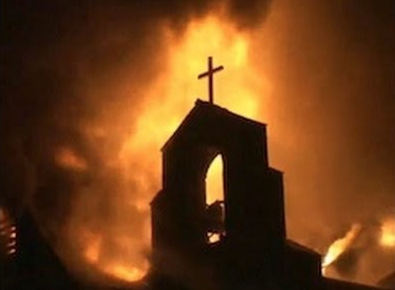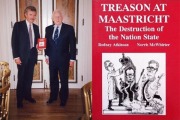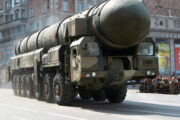“In some areas of the Middle East where church bells have rung for centuries on Christmas Day, this year they will be silent,” President Barack Obama said in a statement on December 23. “This silence bears tragic witness to the brutal atrocities committed against these communities by ISIL.” This is a misleading and hypocritical statement for four main reasons.
(1) Obama singles out the Islamic State (IS, or “ISIL” as he still insists on calling it) as the culprit. He is thus creating the impression that anti-Christian “brutal atrocities” had been absent before the IS made its appearance on the Middle Eastern scene, or that such atrocities are limited to the IS-controlled areas today. This is demonstrably untrue.
It is a matter of historical record that the 75 years preceding the dissolution of the Ottoman Empire in 1922 witnessed a more thorough destruction of the Christian communities in the Middle East than any period following the seventh century Islamic conquest. Thousands of Assyrians were murdered in the province of Mosul in 1850, and in 1860 some 12,000 Christians were put to the sword in Lebanon. Successive slaughters of Armenians in Bayazid (1877), Alashgurd (1879), Sassun (1894), Constantinople (1896), Adana (1909) and Ottoman-ruled Armenia itself (1895–1896) claimed a total of 200,000 lives. They were but rehearsals for the slaughter of 1915-1918, which claimed at least a million lives. Two million Armenians lived in what is now Turkey in 1914; some 3% (ca. 60,000) remain today. The proof of the genocide is in the numbers.
Further south, the slaughter of Christians in Alexandria in 1881 was but a rehearsal for the famine induced by the Turks in 1915–1916 that killed over 100,000 Maronite Christians in Lebanon and Syria. So imminent and ever-present was the peril, and so fresh the memory of these events in the minds of the non-Muslims, that illiterate Christian mothers dated events as so many years before or after “such and such a massacre.” Across the Middle East, the bloodshed of 1915–1922 crippled ancient Christian communities and cultures that had survived since Roman times. The carnage peaked with the destruction of Pontic Greeks after World War I had ended.
In recent years, the exodus of Iraq’s Christian community was near-complete years before the IS appeared. The Christian community in Iraq was up to 1.5 million strong before the U.S.-led invasion of 2003. Four-fifths of them are estimated to have left the country in recent years following a relentless string of attacks by Islamic extremists. Their numbers were down to 500,000 in 2009, and as low as 200,000 in mid-2014. While they were still there, the U.S. forces did next to nothing to protect them. Ever since they were reconstituted after the occupation, the Iraqi army and police have been either unable or unwilling to do so.
(2) Policies pursued by the Obama Administration have been consistently detrimental to the position of the Christian remnant in the Middle East. In Egypt it supported the Muslim Brotherhood government under Mohamed Morsi (2012-2013). Hillary Clinton in particular behaved like its chief apologist and abettor, even though the Islamist regime had acted swiftly, unconstitutionally and illegally to turn the country into an Islamic republic. This would have spelled disaster for some 9 million Copts—the largest Christian community in the Middle East—who had already experienced a massive escalation of lethal violence during the Brotherhood’s brief tenure. Instead of condemning the attacks, on November 28, 2012, Hillary Clinton’s right-hand woman Victoria Nuland declared that Morsi was seeking dialogue “with other stakeholders in Egypt” and that he was not an autocrat. Until the very end—until General Sisi’s July 2013 coup, that is—the Administration had tried to force Egypt’s generals not to challenge Morsi’s usurpation of full authority.
In Syria the Obama administration remains committed to supporting the rebels, although there are no “moderates” among them: all meaningful forces on the ground are Sunni fundamentalists who persecute Christians. According to a (London) Daily Telegraph report from last January, the Turkish-supported rebels “had shown both purpose and glee in their destruction of Christian sites” in the town of Kessab, in the Latakia province, from which all 2,500 Christian residents were forced to flee. Even NPR reported last July that “the Coalition has extremists in its own ranks who have mistreated Christians and forced them out of their homes.”
Government-controlled parts of Syria are the country’s only regions where its 2.5 million Christians are safe from religious persecution, and where they are treated as equals with their Muslim neighbors. The regime’s downfall would be followed by massive carnage, by new waves of refugees heading west, and by the imposition of a jihadist dictatorship. Whether it would be controlled by the al-Qaeda affiliated al-Nusra front—the dominant opposition fighting force—or by ISIS would be irrelevant to the Christians who would be murdered, exiled, or enslaved under sharia dhimmitude. That the Obama administration persists in its single-minded support for this grim scenario indicates the extent to which it is indifferent to the fate of Syria’s Christians, Obama’s rhetoric notwithstanding.
(3) Policies pursued by some American “allies” in the Middle East have been hugely detrimental to the Christian remnant in the region, but the Obama Administration has not used its influence to change such policies. For decades Saudi Arabia and the Gulf monarchies have made massive investments in education systems and schools across the region that indoctrinate students in the ideology of Islamic supremacism. In recent years they “have played a significant role in the broader struggle for power that is affecting Christians . . . particularly with the flows of money from some Gulf countries to extremist and terrorist groups that have targeted Christians.” The Administration has not expressed its concern over such policies, let alone taken diplomatic steps to have them terminated.
(4) The Obama Administration discriminates against Christians when deciding which refugees from the region should be allowed into the United States. The U.S. has resettled 2,192 Syrian refugees in 2015. Of that number, 2089 (95%) were Sunni Muslim and 31 (1.4%) were Christian. According to the 2015 CIA Factbook, Christians account for 10% of Syria’s population. This means that Christians are so visibly under-represented – even more so if we take into account the fact that they are the most vulnerable single religious group in Syria, being dispersed, largely urban, and thus unable to establish a compact defensible redoubt. It is even more remarkable that Sunni Muslims are significantly over-represented—they are just over 70% of Syria’s population—even though they are the least threatened religious group in the country.
With friends like Obama, the Christian remnant in the Middle East needs no jihadi enemies.


















